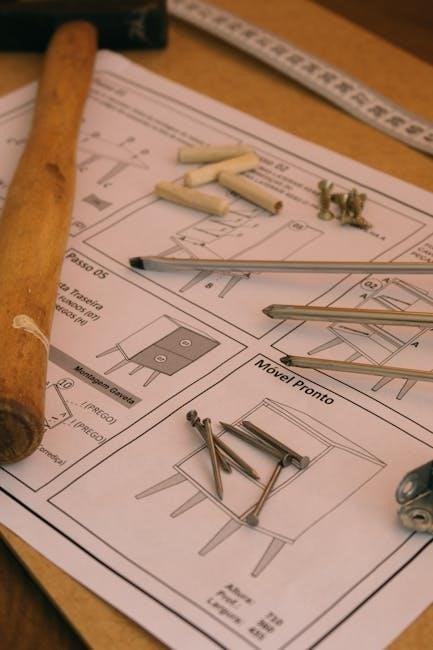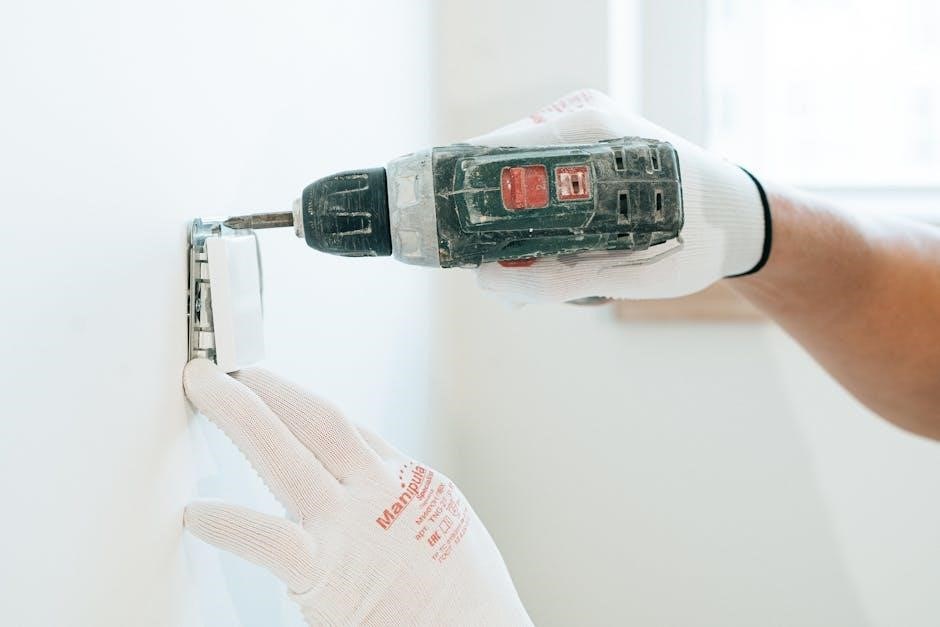Overview of 10×10 Gazebo Assembly
Assembling a 10×10 gazebo involves multiple steps, starting with the frame and culminating in a secure, stable structure. The process often requires two adults and some tools, with easy-to-follow instructions.
Preparation Before Assembly
Prior to starting the assembly, ensure you have a level foundation. Gather all necessary tools, and clear the area. Account for all parts using the included inventory list. Read the instructions fully!
Checking Parts and Inventory
Before commencing the assembly of your 10×10 gazebo, a meticulous check of all components against the provided parts list is paramount. This crucial step ensures that no parts are missing, which could halt or complicate the assembly process later on. Begin by laying out all the components in an organized manner, grouping similar items together for easy identification. Carefully compare each item to the illustrations and descriptions in the instruction manual. Pay close attention to the quantity of each part, as discrepancies can easily occur. Check for any signs of damage, such as dents, scratches, or broken pieces, which may have occurred during shipping or handling. If any parts are missing or damaged, contact the manufacturer or retailer immediately to request replacements. It is advisable to keep the original packaging materials until you are certain that all parts are accounted for and in good condition. This will facilitate the return or exchange process if necessary. Furthermore, familiarize yourself with the names and functions of each part, as this will greatly aid in understanding the assembly instructions. By taking the time to thoroughly check the parts and inventory, you can prevent frustration and delays during the assembly process and ensure a smooth and successful construction of your 10×10 gazebo. This proactive approach will ultimately save you time and effort in the long run, allowing you to enjoy your new outdoor space sooner. Remember, a well-prepared start is essential for a successful finish.
Frame Assembly
The frame assembly is a critical stage, providing the foundational structure for your 10×10 gazebo. It involves connecting various frame components, ensuring stability and proper alignment for subsequent steps.
Laying Out and Connecting Frame Components
Initiate the frame assembly process by carefully laying out all the frame components in an organized manner. This step is crucial for a smooth and efficient assembly. Refer to the provided parts list and diagrams in the instruction manual to identify each component correctly. Ensure you have ample space to work and that the area is clear of any obstructions. Begin by connecting the corner posts or support posts, depending on your gazebo model. These posts typically form the vertical supports of the frame. Use the appropriate connectors, such as bolts, screws, or snap-lock mechanisms, to securely join the posts together. Double-check that the connections are tight and stable before moving on. Next, attach the horizontal beams or crossbeams that connect the posts. These beams provide lateral support and help to create the rectangular or square shape of the gazebo frame. Again, use the designated connectors to firmly secure the beams to the posts. Pay close attention to the orientation of the beams, ensuring they are aligned correctly according to the instructions. As you connect the frame components, periodically check the overall squareness and alignment of the frame. Use a level and a measuring tape to ensure that the posts are plumb and the beams are horizontal. Make any necessary adjustments to correct any misalignments. Once the main frame is assembled, you may need to add additional support structures, such as diagonal braces or corner brackets. These components further enhance the stability and rigidity of the frame. Attach them securely to the posts and beams using the appropriate fasteners. Throughout the frame assembly process, it is essential to follow the instructions carefully and double-check all connections. A well-assembled frame is the foundation of a sturdy and long-lasting gazebo. If you encounter any difficulties or uncertainties, consult the instruction manual or seek assistance from a qualified professional.

Roof Assembly
The roof assembly is a critical step, involving either attaching roof panels or fabric. This stage often requires careful alignment and secure fastening to ensure weather resistance and structural integrity.
Attaching Roof Panels or Fabric
Attaching the roof panels or fabric is a crucial phase in the 10×10 gazebo assembly, directly impacting its weather resistance and overall aesthetic. Begin by carefully unpacking all roofing components, whether they are galvanized steel panels, aluminum sections, or fabric canopies, and ensure you have all the necessary hardware, such as screws, bolts, or clips. For hardtop gazebos with steel or aluminum roofs, it’s essential to handle the panels with care to avoid bending or scratching the finish; placing them on a non-abrasive surface during assembly is highly recommended. Follow the manufacturer’s instructions meticulously, as the order and method of attachment can vary significantly between models. Typically, you’ll start by connecting the roof panels to the frame’s upper structure, ensuring each panel is properly aligned and securely fastened. This may involve pre-drilled holes and specific screw patterns to maintain structural integrity. For fabric canopies, stretch the material evenly over the frame, securing it with provided ties, straps, or hook-and-loop fasteners. Ensure the fabric is taut to prevent sagging and water pooling, which can damage the gazebo and reduce its lifespan. Double-check all connections to guarantee they are tight and secure, providing a robust and weatherproof roof that will withstand various weather conditions, from wind and rain to snow and sun. Remember to consult the assembly manual for specific torque settings for screws and bolts to avoid over-tightening and potential damage. If using a BILT app for guidance, follow the interactive steps closely for a streamlined and accurate roof attachment process. Finally, inspect the completed roof assembly to ensure there are no gaps, loose connections, or areas where water could potentially penetrate, ensuring a durable and enjoyable outdoor space.
Securing the Gazebo
Proper anchoring is vital for 10×10 gazebos. Use ground nails, ropes, or expansion screws based on the surface. This prevents injuries and damage from wind, ensuring stability and safety.
Anchoring to the Ground
Once the 10×10 gazebo frame and roof are assembled, securing it to the ground is a crucial step for ensuring its stability and safety. The method used for anchoring will depend on the type of surface where the gazebo is being installed. For soft surfaces like grass or soil, ground nails or stakes are typically used. These are driven into the ground through the base plates of the gazebo posts, providing a firm hold. It’s important to use stakes that are long enough to penetrate deep into the ground, ensuring they can withstand wind and other forces. For harder surfaces like concrete or wood decks, expansion screws or bolts are necessary. These require pre-drilling holes into the surface and then screwing in the bolts, which expand to grip the material. This provides a much stronger and more secure connection than stakes alone. In some cases, it may be necessary to use a combination of anchoring methods, depending on the specific conditions of the installation site. For example, if the gazebo is being installed on a patio with some areas of grass around it, stakes could be used in the grass areas and bolts in the patio areas. Regardless of the method used, it is essential to ensure that all anchor points are securely fastened and that the gazebo is level and stable before using it. Regularly inspect the anchors to ensure they remain tight and in good condition, especially after periods of strong winds or heavy rain. Taking these precautions will help to prevent the gazebo from tipping over or being damaged, ensuring that it provides a safe and enjoyable outdoor space for years to come. Remember to always consult the manufacturer’s instructions for specific anchoring recommendations for your particular gazebo model.

Safety Precautions
Prioritize safety during the assembly of your 10×10 gazebo. Wear protective gear, like gloves, and ensure a clear workspace. Always have assistance, and be mindful of weather conditions to prevent accidents.
During Assembly Process
During the assembly of your 10×10 gazebo, several safety precautions must be observed to prevent injuries and ensure a smooth construction process. First and foremost, always wear appropriate personal protective equipment (PPE). This includes safety glasses to protect your eyes from debris, work gloves to provide a better grip and protect your hands from sharp edges, and sturdy footwear to prevent foot injuries. Make sure your clothing is appropriate; avoid loose clothing that could get caught in the structure.
Before you begin, thoroughly read and understand all the instructions provided by the manufacturer. Familiarize yourself with the parts list and the assembly steps. If anything is unclear, consult the documentation or contact customer support for clarification. Ensure that you have all the necessary tools readily available and in good working condition. A well-organized workspace will minimize trip hazards and make the assembly process more efficient.
Work with at least one other person during the assembly. Many gazebo components are large and heavy, requiring more than one person to lift and position them safely. Coordinate your actions with your partner to avoid strains and drops. When lifting heavy objects, use proper lifting techniques: bend your knees, keep your back straight, and lift with your legs. Avoid twisting your body while lifting.
Be aware of your surroundings and ensure that the assembly area is clear of obstructions and hazards. Keep children and pets away from the construction site. Work on a level surface to prevent the gazebo from becoming unstable during assembly; If you are working outdoors, be mindful of the weather conditions. Avoid assembling the gazebo in high winds or during a storm.
Take frequent breaks to avoid fatigue. Fatigue can lead to mistakes and injuries. Stay hydrated by drinking plenty of water, especially in hot weather. If you experience any pain or discomfort, stop working and rest.
When using tools, follow the manufacturer’s instructions and safety guidelines. Use the right tool for the job and avoid forcing tools. Keep your hands and fingers away from moving parts. If you are using power tools, wear hearing protection.
Be cautious when working at heights. Use a sturdy ladder or platform and ensure that it is properly positioned and secured. Avoid reaching too far or leaning excessively. Have someone spot you when you are working on a ladder.
Finally, double-check all connections and fasteners to ensure that they are secure. Loose connections can weaken the structure and make it unstable. After the gazebo is fully assembled, inspect it thoroughly to identify any potential hazards or defects. Address any issues promptly to ensure the safety and longevity of your gazebo.

Tools Required
Assembling your 10×10 gazebo typically requires a few essential tools. You’ll likely need a wrench, screwdriver (Phillips and flathead), level, measuring tape, and possibly a rubber mallet for gentle adjustments.
List of Necessary Tools
To ensure a smooth and efficient 10×10 gazebo assembly, gathering the right tools beforehand is crucial. A comprehensive toolkit will not only expedite the process but also minimize the risk of damaging the gazebo components. Begin with a high-quality screwdriver set, including both Phillips head and flathead screwdrivers in various sizes, to accommodate the different screw types used in the assembly. A socket wrench set, along with adjustable wrenches, will be essential for tightening bolts and nuts securely. A rubber mallet can be used to gently tap pieces into place without causing scratches or dents.
A measuring tape is indispensable for ensuring accurate placement and alignment of the frame components. A level, preferably a spirit level, is vital for verifying that the gazebo is perfectly horizontal and vertical, which is critical for its stability and appearance. Work gloves will protect your hands from sharp edges and splinters during the assembly process. Safety glasses are also recommended to shield your eyes from debris or accidental impacts.
Depending on the gazebo’s anchoring system, you might need a drill with appropriate drill bits for creating pilot holes in the ground or deck. A hammer will be necessary for driving stakes or anchors into the ground. A ladder or step stool may be required to reach higher sections of the gazebo during roof assembly. Finally, a utility knife or box cutter can be used for opening packaging and trimming any excess material. Having these tools readily available will significantly streamline the 10×10 gazebo assembly process, ensuring a sturdy and aesthetically pleasing result. Remember to consult the specific instructions for your gazebo model, as some may require specialized tools.

Post-Assembly Inspection
After assembling your 10×10 gazebo, a thorough inspection is vital. Check all connections for tightness and stability. Ensure proper anchoring and look for any signs of stress or potential weaknesses in the structure;
Checking Stability and Connections
Once the gazebo assembly is complete, a meticulous inspection of its stability and all connections is paramount. This step ensures the gazebo’s safety and longevity. Begin by visually inspecting every connection point, including bolts, screws, and interlocking mechanisms. Confirm that each fastener is securely tightened and properly engaged. Loose connections can lead to instability and potential collapse, especially under adverse weather conditions like wind or snow. Gently apply pressure to different sections of the frame to assess overall stability. The gazebo should stand firm and resist movement. Pay close attention to the points where the roof panels or fabric attach to the frame. These are critical areas that bear significant stress; Verify that the anchoring system is effectively securing the gazebo to the ground. This may involve checking ground nails, ropes, or expansion screws, depending on the type of anchoring used. Ensure that these anchors are firmly embedded in the ground and that the gazebo cannot be easily lifted or shifted. If the gazebo includes netting or curtains, inspect their attachment points as well, making sure they are securely fastened and can withstand moderate tension. Finally, step back and observe the gazebo as a whole. Look for any signs of unevenness, warping, or misalignment. These issues may indicate underlying problems with the assembly or the components themselves. Addressing these concerns promptly will prevent further damage and ensure that your gazebo provides a safe and enjoyable outdoor space for years to come. Remember to consult the manufacturer’s instructions for specific guidance on post-assembly inspection procedures.


